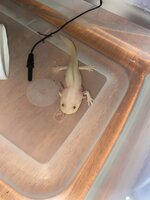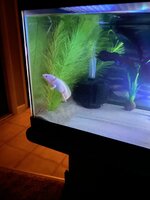LotlMom21
New member
Hi there! I’ve struggled with my axolotl since I got it back in April. Was tubbed constantly due to fungus and tank issues, and hasn’t really grown. I got it from a reputable breeder so I don’t think genetics or prior care is an issue. I was FINALLY able to get him into his/her tank about a month ago and all was well. He/she finally started eating very well and overall just seemed to be thriving. In a 20 gallon I run 2 sponge filters both rated for 40gallon tanks as well as a small bubble light. I do small (10%-ish) water changes twice a week just to keep up on it.
Fast forward to day before yesterday and I notice lack of hill filaments over night. Immediately I tubbed it and tested my water. Well… cycle has crashed. Nitrites AND Nitrates are both through the roof and I’ve got about 3ppm ammonia. PH is the only good number at 7.4…
My babe has lost ALL it’s floofs (which we’re pretty scarce to begin with) and it’s already small gill stocks are even smaller now. He/she also won’t eat. I’m giving tea baths and the tub is filled with primed water kept around 63, a hide, and an air stone.
What else can I do to help my little babe while I get the tank cycle back? I’m so scared I’m going to lose it
: first picture is tank setup
: 2nd picture was just now

Fast forward to day before yesterday and I notice lack of hill filaments over night. Immediately I tubbed it and tested my water. Well… cycle has crashed. Nitrites AND Nitrates are both through the roof and I’ve got about 3ppm ammonia. PH is the only good number at 7.4…
My babe has lost ALL it’s floofs (which we’re pretty scarce to begin with) and it’s already small gill stocks are even smaller now. He/she also won’t eat. I’m giving tea baths and the tub is filled with primed water kept around 63, a hide, and an air stone.
What else can I do to help my little babe while I get the tank cycle back? I’m so scared I’m going to lose it
: first picture is tank setup
: 2nd picture was just now


